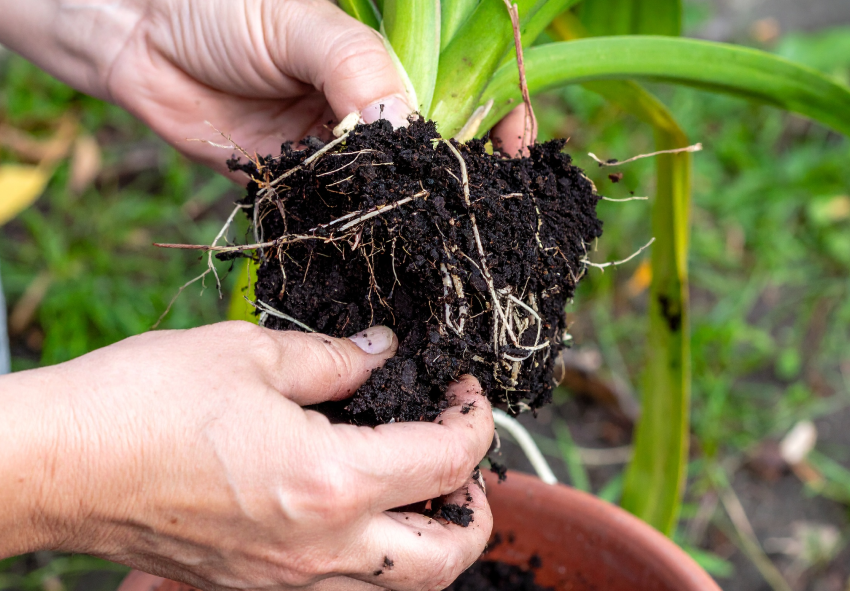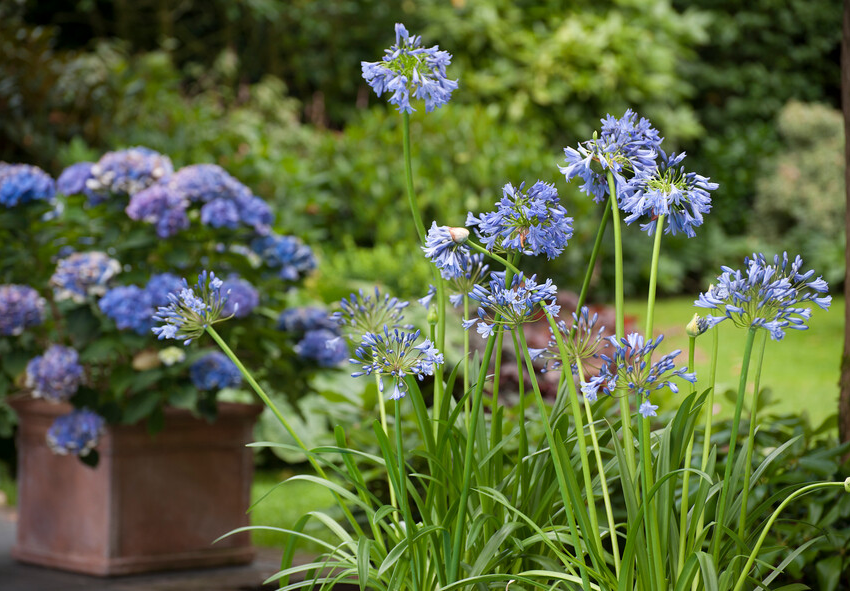Agapanthus, also known as Lily of the Nile or African Lily, are striking perennials with globe-shaped flower clusters. Their tall stems and rich blue or white blooms make them ideal statement plants. Growing Agapanthus in pots is a smart choice for gardeners with limited space, or those seeking to move plants easily based on season or sunlight. Our gardening blog is a perfect place to find all the information you nzzzzeed!
Choosing the Right Agapanthus Variety
Selecting the right Agapanthus variety is the first step toward success in containers. Some types are better suited for pot life, especially more compact cultivars. Understanding the difference between evergreen and deciduous varieties is also important for seasonal care.
Evergreen vs. Deciduous Types
Evergreen Agapanthus retain their foliage year-round and prefer mild climates, making them ideal for warmer zones or sheltered patios. Deciduous varieties, on the other hand, go dormant in winter and are often more cold-hardy. Knowing which type you have will determine your winter care approach and placement strategies.
Best Varieties for Containers
Compact Agapanthus like ‘Peter Pan,’ ‘Blue Heaven,’ or ‘Northern Star’ thrive in pots due to their manageable size and robust flowering habits. These cultivars offer vibrant blue or purple hues and require less staking. Choosing dwarf or semi-dwarf varieties helps prevent overcrowding and makes care much simpler in a container setting.
Preparing the Perfect Pot and Soil
Providing the right pot and soil ensures healthy growth and vibrant blooms. Agapanthus needs good drainage and a slightly snug environment to encourage flowering. Choosing the proper container and soil mix sets a solid foundation for potted success.
- Ideal Container Size and Type: Agapanthus prefers to be slightly root-bound, so choose a pot that is only a few inches wider than the root ball. Terracotta or plastic pots with ample drainage holes are best to avoid waterlogging. Deep pots (at least 12 inches) are ideal for supporting tall flower stems and anchoring the roots.
- Best Soil Mix for Agapanthus: Use a free-draining potting mix, ideally a combination of peat-free compost, coarse sand, and perlite or fine bark. This type of soil prevents excess moisture buildup, which can cause root rot. Avoid heavy garden soil that compacts easily in containers.
How to Plant Agapanthus in Pots
Planting Agapanthus in containers is straightforward but requires attention to root depth and spacing. Planting at the correct level helps with flower production and prevents rot. A healthy start leads to long-lasting success.
Proper Planting Depth and Spacing
Set the plant so the crown sits just at or slightly above the soil line. Roots should be spread gently without bending or crowding. Space plants to allow for air circulation if using large planters with multiple Agapanthus.
First Watering and Initial Care
After planting, water thoroughly to settle the soil around the roots. Check that excess water drains freely from the bottom of the pot. Keep the plant in a sheltered area for a few days before placing it in full sun.
Watering and Feeding Potted Agapanthus

Though drought-tolerant once established, Agapanthus still needs consistent care in containers. Regular watering and feeding encourage stronger blooms and fuller foliage. Adjust your care routine according to the season and pot size.
Watering Frequency by Season
In spring and summer, water when the top inch of soil feels dry — usually once or twice a week, depending on temperature. Reduce watering in autumn and winter, especially for deciduous types. Always allow the soil to dry slightly between waterings to prevent rot.
Best Fertilizers for Container Agapanthus
To keep your potted agapanthus thriving and blooming beautifully, the right fertilizer is key. Container-grown plants rely entirely on the nutrients you provide, so choosing the appropriate formula and feeding schedule makes a big difference. Below are some of the best fertilizer options to support lush foliage and abundant flowers:
- Balanced Liquid Fertilizer (e.g., 10-10-10 or 20-20-20): A general-purpose liquid fertilizer with equal parts nitrogen, phosphorus, and potassium promotes healthy overall growth and vibrant blooms. Apply every 2–4 weeks during the growing season.
- Slow-Release Fertilizer Pellets: These granules gradually release nutrients over time, reducing the need for frequent feeding. Ideal for busy gardeners and especially useful at the start of the season.
- Bloom-Boost Fertilizer (e.g., 15-30-15): High-phosphorus formulas encourage strong flower production and are best used once bud formation begins. Avoid using too often to prevent nutrient imbalance.
- Seaweed or Kelp Extract: Organic and rich in trace minerals, seaweed fertilizer enhances root strength and helps plants resist stress. It’s a great supplement alongside standard fertilizers.
- Bone Meal (Organic): A natural source of phosphorus that supports root and flower development. Mix into the potting mix before planting or apply lightly around the root zone during early growth stages.
Encouraging Healthy Blooms
To get the best performance from Agapanthus in pots, ensure they receive proper sunlight and seasonal grooming. Blooming typically starts in early summer and lasts several weeks. A few simple tips can make a big difference.
Sunlight Requirements
Agapanthus thrives in full sun — at least 6 hours per day is ideal for container plants. Insufficient light leads to fewer or no flowers. If your patio is shady, consider moving your pots to a sunnier spot as the seasons shift.
Deadheading and Pruning Tips
Remove faded flowers promptly to encourage new blooms and maintain tidiness. After flowering ends, cut the stalks back to the base without damaging foliage. Prune any yellowing leaves to keep the plant healthy and attractive.
Overwintering and Seasonal Care

Caring for Agapanthus during winter helps ensure a vibrant display the following year. Evergreen and deciduous types have different needs in cold weather. Proper seasonal care protects the plant and prepares it for regrowth.
Protecting from Frost
While agapanthus is known for its resilience, it can suffer damage or die back in freezing temperatures — especially in containers. Since potted plants are more exposed to cold than in-ground ones, frost protection is essential during winter. Use these methods to help safeguard your container-grown agapanthus:
- Move Pots Indoors or to a Sheltered Spot: Relocate containers to a frost-free area such as a garage, greenhouse, or covered porch. Even placing them against a south-facing wall can make a big difference.
- Wrap Pots with Insulation: Use burlap, bubble wrap, or horticultural fleece to insulate the pot and protect roots from freezing. Avoid wrapping the foliage to prevent moisture buildup.
- Apply Mulch Over the Soil Surface: Add a thick layer of straw, bark, or compost on top of the soil to help insulate the root zone. This also prevents sudden temperature fluctuations.
- Reduce Watering in Cold Weather: Keep the soil slightly dry to avoid waterlogged roots, which are more vulnerable to frost damage. Water sparingly during dormancy.
- Use Frost Covers on Cold Nights: Drape breathable frost cloth or garden fleece over the plant during nighttime cold snaps. Remove it during the day to let light and air in.
Reducing Watering and Fertilizer
Stop feeding by early autumn and reduce watering as the plant enters dormancy. Keep the soil barely moist — dry but not bone-dry. This rest period is crucial for next year’s blooming cycle.
Conclusion
Growing Agapanthus in pots is both rewarding and manageable, even for beginners. With proper care — choosing the right variety, providing good soil and drainage, regular feeding, and winter protection — your container-grown Agapanthus will thrive. Whether on patios, balconies, or in small gardens, their bold blooms add long-lasting beauty and tropical flair!
Frequently Asked Questions (FAQs) about Growing Agapanthus in Pots
1. Can agapanthus grow well in containers?
Yes, agapanthus thrives in containers, especially when provided with good drainage and plenty of sunlight. Potted agapanthus is ideal for small gardens, patios, and balconies. Container growing also allows for easier overwintering, as the pots can be moved indoors or to sheltered areas when temperatures drop.
2. What size pot is best for agapanthus?
A medium to large pot—about 30–40 cm (12–16 inches) in diameter—is ideal. Agapanthus likes to be slightly root-bound, which encourages better blooming. However, the pot should still offer enough room for root development and have drainage holes to prevent waterlogging, which can lead to root rot.
3. How can I order agapanthus bulbs from your online store?
Ordering agapanthus from our online store Dutch-bulbs.com is simple and secure. Just browse our catalog, select your preferred variety, and choose the pot size or quantity. We carefully package each plant to ensure it arrives healthy and ready to grow.
4. How often should I water potted agapanthus?
Water regularly during the growing season, allowing the top inch of soil to dry between waterings. Overwatering can cause root rot, especially in cooler months. During winter, reduce watering significantly to keep the roots from staying too wet while the plant is dormant.
5. What type of fertilizer should I use?
Use a balanced liquid fertilizer or one higher in potassium to promote flowering, such as a tomato feed. Apply every 2–4 weeks during the growing season (spring to summer). Avoid high-nitrogen fertilizers, which encourage leafy growth at the expense of blooms.
Published: 29.07.2025

